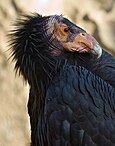主题:动物
欢迎来到动物主题!动物,或称后生动物(Metazoan),是一群多细胞真核生物,在生物分类学上构成名为动物界(学名:Animalia)的分类阶层。除了少数特例外,绝大多数动物会消耗有机物质,呼吸氧气,能够移动,能够进行有性生殖,在胚胎发育过程中从细胞的空心球(囊胚)中生长。目前已有逾150万个现生的动物物种被发表,其中昆虫是占比最高的类群,约有100万种——据估计,现生动物物种的实际总数可能超过700万,而昆虫占了超过九成。动物的全长从8.5×10−6米到33.6米不等。它们彼此之间和它们的生活环境间有着复杂的相互作用,形成了复杂的食物网。动物之中包括人类,但在口语中,“动物”一词通常指人类以外的动物。针对动物的科学研究称为动物学。 精选条目加州神鹫(学名:Gymnogyps californianus)属于美洲鹫科新大陆秃鹫家族,为北美洲大陆最大的鸟类。如今这种鹫只生活在科罗拉多大峡谷区域以及加利福尼亚州和下加利福尼亚州北部西海岸的群山中。它是加州兀鹫属中唯一存活的物种。 加州神鹫是一种大型黑色的秃鹫,翅膀下面有白色的小块,头部秃毛,根据其情绪的不同,显露的皮肤颜色为微黄色到鲜红色。在所有北美洲的鸟类中其翼幅最宽,同时也是最重的鸟类之一。加州神鹫是食腐动物,吃大量的腐肉。它是世界上寿命最长的鸟类之一,其寿命可达50年。 19世纪以来,由于非法狩猎、铅中毒和栖息地破坏,加州神鹫的数量急遽减少。最终,美国于1987年执行了一项自然保护运动计划,捕获了所有存活的野生加州神鹫,总计22只鸟被豢养在圣迭戈野生动物园和洛杉矶动物园。从1991年起,数量开始有所增长,加州神鹫又被重新放归山林。这项工程是美国迄今以来最昂贵的物种保护工程。加州神鹫是世界上最稀少的鸟类之一。到2008年12月,据统计只剩有327只存活的加州神鹫,其中半数以上为野生。[1] 加州神鹫对于很多加州印第安人的文化具有重要意义,作为一个重要角色出现在一些传统的美国原住民神话中。 The California condor (Gymnogyps californianus) is a New World vulture, the largest North American land bird. This condor became extinct in the wild in 1987 (all remaining wild individuals were captured), but the species has been reintroduced to northern Arizona and southern Utah (including the Grand Canyon area and Zion National Park), the coastal mountains of central and southern California, and northern Baja California. Although other fossil members are known, it is the only surviving member of the genus Gymnogyps. The species is listed as critically endangered by the IUCN. The plumage is black with patches of white on the underside of the wings; the head is largely bald, with skin color ranging from gray on young birds to yellow and bright orange on breeding adults. Its huge 3.0米(9.8英尺) wingspan is the widest of any North American bird, and its weight of up to 12千克(26磅) nearly equals that of the trumpeter swan, the heaviest among native North American bird species. The condor is a scavenger and eats large amounts of carrion. It is one of the world's longest-living birds, with a lifespan of up to 60 years.[2] Condor numbers dramatically declined in the 20th century due to poaching, lead poisoning, and habitat destruction.[3] A conservation plan was put in place by the United States government that led to the capture of all the remaining wild condors which was completed in 1987, with a total population of 27 individuals.[4] These surviving birds were bred at the San Diego Wild Animal Park and the Los Angeles Zoo. Numbers rose through captive breeding and, beginning in 1991, condors were reintroduced into the wild. The California condor is one of the world's rarest bird species: as of December 2015 there are 435 condors living wild or in captivity.[5] The condor is a significant bird to many Californian Native American groups and plays an important role in several of their traditional myths.
精选图片 金蟾蜍(学名:Bufo periglenes),又称环眼蟾蜍,美洲蟾蜍的一种,曾大量存在于哥斯达黎加蒙特维多云雾森林(Monteverde Cloud Forest Reserve,现已为自然保护区)中一片狭小的热带雨林地带,其雄性个体全身呈金黄色,因此被称作金蟾蜍。金蟾蜍1966年由爬虫学者杰伊·萨维奇(Jay Savage)发现并正式命名,1989年以后,金蟾蜍再没有被发现。至2006年,金蟾蜍在世界自然保护联盟濒危物种红色名录中的保护状况为绝灭,由于全世界范围内两栖动物数量不断下减,金蟾蜍绝灭的实例也被许多相关学者研究,一般认为,造成金蟾蜍绝灭的主要原因为全球变暖和环境污染。 The golden toad (Bufo periglenes) is an extinct species of true toad that was once abundant in a small region of high-altitude cloud-covered tropical forests, about 30 km2(12 sq mi) in area, above the city of Monteverde, Costa Rica. The last reported sighting of a golden toad was on 15 May 1989. Its sudden extinction may have been caused by chytrid fungus and extensive habitat loss. 你知道吗?精选动物
The 美洲豹(学名:Panthera onca),也叫美洲虎,是豹属动物,胎生,乃猫科中继虎和狮之后的第三大物种,同时亦为西半球最大型和最强健的猫科动物,外表型态的确和豹极为相似,但较粗壮,圆斑中有黑点,生态位也较像虎。是美洲地区唯一的豹属动物。现时美洲豹分布于墨西哥至中美洲大部分地区,南至巴拉圭及阿根廷北部。除了已被发现在亚利桑那州的美洲豹繁殖族群(在图森南部),美洲豹自1900年代初开始就已在美国消失(地区性绝种)。虽然如此,一些美洲豹的族群仍然很可能存在于美国一些未被观察的地区,包括南亚利桑那州、新墨西哥州甚至德克萨斯州。
美洲豹的外貌与豹非常相似,但其体型一般比豹大,身躯也和虎一样健壮,行为和栖息的习性也与虎相似。美洲豹较喜欢栖于树木茂密的热带雨林,但它们亦会广泛分布于高山、平原等不同的地方。它们生活于多水之地,且跟虎一样,是喜欢游泳的猫科动物。美洲豹爱独行,是蛰伏突袭的掠食者,在选择猎物方面,它们完全是投机取巧的。它们是顶级掠食者和基石物种,在平衡生态系统和调节猎物数量方面占著举足轻重的地位。美洲豹有异常惊人的咬力,甚至比其他大猫也强得多[6],让它们能咬穿爬行动物的厚皮或甲壳[7]和使用一种不常见的杀戮方式:直接把猎物的颅骨从耳部咬穿,对猎物的脑部造成致命的损伤。[8] 豹是近危物种,其数量至今仍然正不断下降。它们的栖息地不断减少,对美洲豹造成很大的威胁。虽然美洲豹的贸易已被全面禁止,但它们仍然常被人类捕杀,尤其是在南美洲,牧场工人和农夫经常与美洲豹发生冲突,而死伤的往往都是美洲豹,令它们的数量继续下降。美洲豹的数量已大幅下降,但其分布地仍然非常广大。美洲豹在很多美洲土著文化的神话中常常出现,包括马雅和阿兹特克。 每月名言When the fox dies, fowls do not mourn. —Anonymous 人类的爱,希望和恐惧与动物没有什么两样,他们就像阳光,出于同源,落于同地。 💖 如果我们了解狗真正的本性,并且知道如何鼓励它们,我们就能成为更好的主人。💖 动物是最可亲近的朋友它们从不提问,也从不指责。💖 —爱略特 只要我们有选择的机会,就应该避免造成其他动物受苦受害。 💖 —施韦泽 钱可以买到一条很优秀的狗,却买不到它摇尾的热情。💖 孩子在成长过程中,倘若未能学到以爱心对待动物的观念,将来可能造成其人格及行为发展的偏差。💖 —欧美研究报告 不相信对毛小孩都不能负责的人 还能对什么负责。💖 —吴念真 接受某种超越人类中心主义的世界观,甚至能够像爱他们自己那样去爱其他动物。💖 —罗尔斯顿 欢迎参与
多媒体资源
|
主题
相关主题
姊妹计划
进入以下维基媒体计划可获取更多相关信息:
- ^ Milestones in California Condor Conservation[失效链接],The Zoological Society of San Diego's Center for Conservation and Research for Endangered Species,2008年1月10日查阅。
- ^ Once nearly extinct, the California condor nears new milestones. CNN. April 27, 2011.
- ^ San Diego Zoo's Animal Bytes: California Condor. The Zoological Society of San Diego's Center for Conservation and Research for Endangered Species. [April 18, 2012].
- ^ Last Wild California Condor Capture for Breeding Program (PDF). U.S. Fish & Wildlife Service (press release). [2009-05-06].
- ^ California Condor Recovery Program. U.S. Fish & Wildlife Service U.S. Fish & Wildlife Service. [19 August 2016].
- ^ Stephen Wroe, Colin McHenry, and Jeffrey Thomason. Bite club: comparative bite force in big biting mammals and the prediction of predatory behavior in fossil taxa (PDF). Proceedings of the Royal Society B (Royal Society). 2006, 272 (1563): 619–625 [2006-08-07]. doi:10.1098/rspb.2004.2986.
- ^ Hamdig, Paul. Sympatric Jaguar and Puma. Ecology Online Sweden via archive.org. [2009-03-19].
- ^ Rosa CL de la and Nocke, 2000. A guide to the carnivores of Central America: natural history, ecology, and conservation. The University of Texas Press. ISBN 978-0-292-71604-9


















